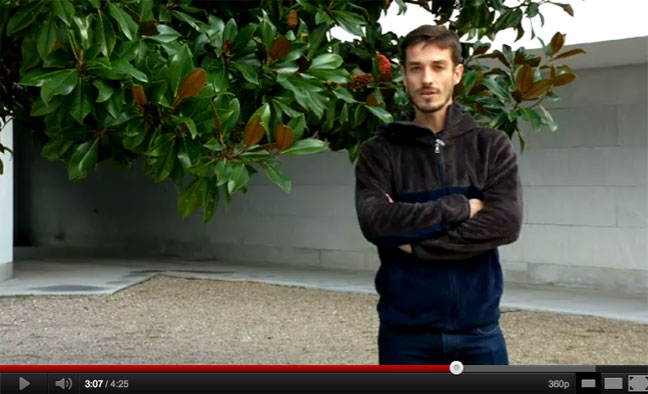6-channel video installation

Video still from ACT IV (Carlos Pizarro), performed by Lisandro López
Description
Set against the 2010 presidential election campaign in Colombia, Six Acts: An Experiment in Narrative Justice is based on a series of performative actions in public squares in Bogotá. Six actors of different social and ethnic backgrounds read peace speeches originally delivered by six Colombian liberal and left-wing political leaders (Jorge Eliécer Gaitán,Luis Carlos Galán, Bernardo Jaramillo Ossa, Jaime Pardo Leal, Carlos Pizarro and Rafael Uribe Uribe) who were assassinated in the last 100 years because of their political ideology.
These “acts” focused on the need to remember the systematic elimination of voices that have dared to oppose the ruling order by articulating their differing points of view and that have denounced by name those responsible for Colombia’s repetitive history of political corruption and violence. Drawing upon the notion of “narrative justice;” that is, justice from the perspective of an aesthetic experience instead of a normative concept, this work offers an exercise of collective memory to underscore its transformative potential.
•
Installation Views
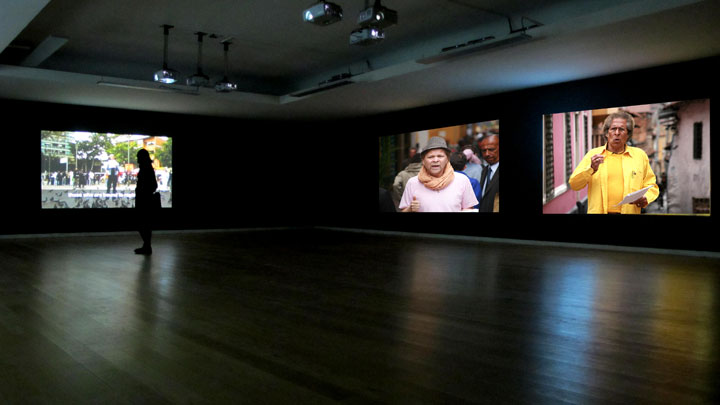
Installation view at Museu Serralves, Porto, 2010
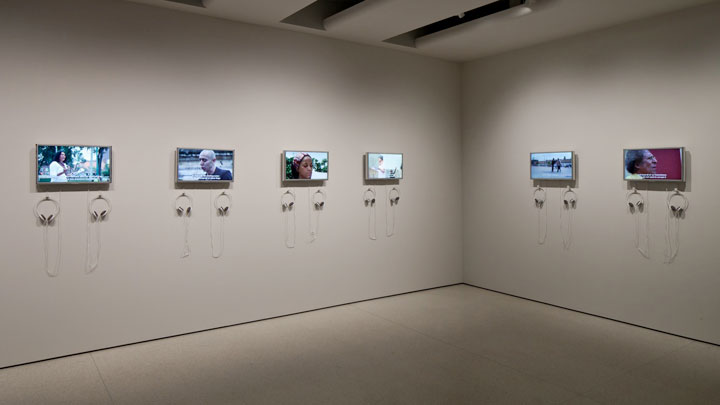 Installation view at Guggenheim Museum, New York, 2011
Installation view at Guggenheim Museum, New York, 2011
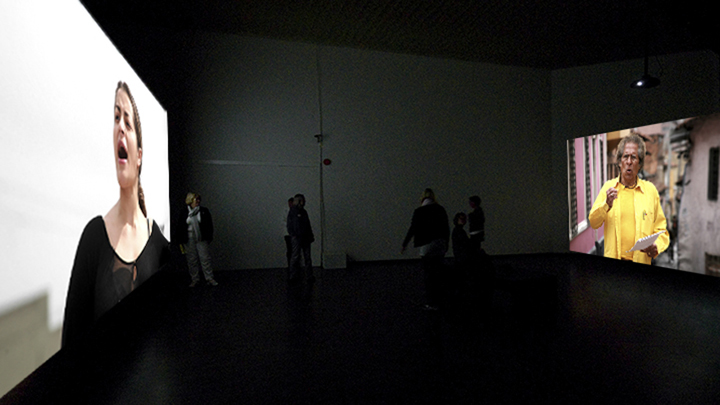 Installation view at Henie Onstad Art Center, Oslo 2011
Installation view at Henie Onstad Art Center, Oslo 2011
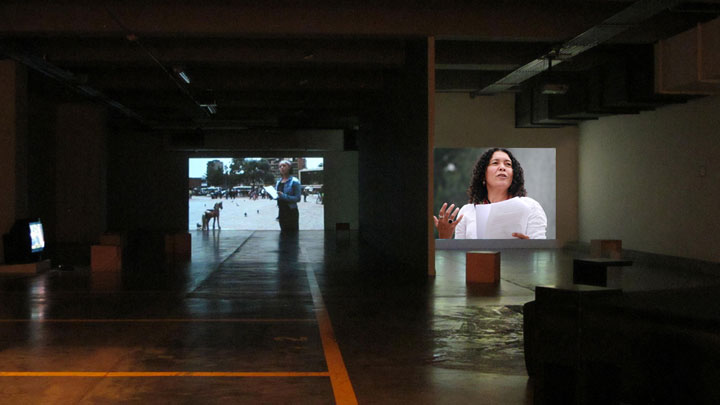 Installation view at El Parqueadero at Museo de Arte del Banco de la República, Bogotá, 2010
Installation view at El Parqueadero at Museo de Arte del Banco de la República, Bogotá, 2010
•
Videos of Performances
ACT I – RAFAEL URIBE URIBE
Speech: Excerpts from “La Patria y la Libertad” (The Homeland and Freedom) by Rafael Uribe Uribe from 1901. Performed by Carmiña Martínez on March 16, 2010 at El Parque Nacional in Bogotá in front of Uribe Uribe’s monument.
ACT II – JORGE ELIECER GAITAN
Speech: “Oración por la Paz” (Prayer for Peace) by Jorge Eliécer Gaitán from 1948. Performed by Dubián Gallego on March 17, 2010 at La Plaza de Bolívar in Bogotá.
ACT III – JAIME PARDO LEAL
Speech: Excerpt of an unidentified speech by Jaime Pardo Leal from 1986. Performed by Ivonne Rodríguez on March 16, 2010 at el Parque de Lourdes in Bogotá.
ACT IV – CARLOS PIZARRO
Speech: “Discurso electoral para la presidencia de Colombia 1990-1994” (Electoral Speech for the Presidency of Colombia 1990-1994) by Carlos Pizarro from 1990. Performed by Lisandro López on March 17, 2010 in the center of Bogotá.
ACT V – LUIS CARLOS GALAN
Speech: “Un programa para la victoria” (A Program for Victory) by Luis Carlos Galán from 1989. Performed by Atala Bernal on March 16, 2010 at el Parque de Soacha where Galán was assassinated.
ACT V (EPILOGUE) – LUIS CARLOS GALAN
Upon the completion of ACT V – LUIS CARLOS GALAN, a group of elderly protestors approached us to ask how we could help with their struggle.
ACT VI – BERNARDO JARAMILLO
Speech: “Por la Paz” (For Peace) by Bernardo Jaramillo from 1989. Performed by Francisco Martínez on March 11, 2010 at el Chorro de Quevedo in Bogotá
•
Exhibition History
Hebbel am Ufer (HAU), Berlin, April, 2010 (Solo)
Museo de Arte del Banco de la República – El Parqueadero, Bogotá, August, 2010 (Solo)
Henie Onstand Kunssenter, Oslo, September 2010 (Group show: “The Creative Act”)
Art Today Association – Center for Contemporary Art, Plovdiv, Bulgaria, September 2010 (Group show: “Dwelling in Travel”)
27th Kassel Documentary Film and Video Festival, Kassel, November 2010 (Group show: “Monitoring Exhibition”)
Museu Serralves, Porto, November 2010 (Group show: “To the Arts Citizens!”)
Stuttgarter Filmwinter, Stuttgart, January 2011 (Group show: “Medien im Raum”)
Guggenheim Museum, New York, February 2011 (Group show: “Found in Translation”)
Wiener Festwochen, Vienna, June 2011 (Solo)
•
Video interview about Six Acts and Deus Pobre: Modern Sermons of Communal Lament (in Spanish)
www.youtube.com/watch?v=sO2PcrIvlDQ
•
Credits
Cameras: Alexandra Posada, Irene Tobón
Editor: Carlos Motta
Still Photography: Carlos Augusto Botero
Actors: Atala Bernal (Luis Carlos Galán), Dubián Gallego (Jorge Eliécer Gaitán), Lisandro López (Carlos Pizarro), Carmiña Martínez (Rafael Uribe), Francisco Martínez (Bernardo Jaramillo), and Ivonne Rodríguez (Jaime Pardo)
Casting: Clara Sofia Arrieta
Locations: Parque de Soacha (Luis Carlos Galán), Plaza de Bolivar (Jorge Eliécer Gaitán), Parque Santander (Carlos Pizarro), Parque Nacional (Rafael Uribe), Chorro de Quevedo (Bernardo Jaramillo), and Parque de Lourdes (Jaime Pardo).
Research Assistants: Sonia Rojas, Hernando González
English Translation of Speeches: Cora Sueldo
Special Thanks: Irit Batsry, Annie Correal, Juan Pablo Echeverri, Felipe Espinoza, Arturo Motta, Cristina Motta, Sylvia Motta, Pedro Salazar, Lorenzo Morales, Franklin Suárez, Juan Gabriel Tokatlián and David van der Leer.
The project was commissioned by Hebbel am Ufer (HAU), Berlin, Germany, and first presented in the context of the festival “Libertad y Desorden: Young Art from Colombia” in April 2010.
•
Interview
Enacting a Manifesto
A conversation between Carlos Motta and Gabriela Rangel
Published in the catalogue of the exhibition “Creative Acts” at the Henie Onstand Kunstsenter in Oslo, 2o10. Download PDF here
Gabriela Rangel: I want to start from the project’s title Six Acts: An Experiment in Narrative Justice, which implies a scientific approach to issues still unresolved in Colombia, all of which seem to arrive from the sociopolitical violence that has modeled the nation’s public life in the last 60 years (or perhaps the last century). Do you intend to bring global awareness on the fact that a number of public speeches, now read by actors were originally delivered by political leaders who were assassinated? Do you want to re-interpret the Brechtian verfremdung by reinserting those speeches back to the present and into the public arena as fictions?
Carlos Motta: Six Acts: An Experiment in Narrative Justice proposes an alternative approach to the concept of justice based on an aesthetic experience rather than a normative judicial process. To this aim, I understand the concept of aesthetics to be an unofficial, artistic, transitory and historical public sphere where narration, speech acts and representation-as-fiction encourage communication amongst citizens. Based on this definition, I consider an aesthetic experience to be a useful way to “construct” justice, which in a country at war like Colombia I deem far from idealistic: it is a necessity. Even though there are several official and cultural initiatives and projects that seek to fight for reparative justice, Colombia tends to be an unjust country that chooses to forget its victims and hence it is largely indebted with them. On the one hand, my intention was to bring awareness to what I think is an ongoing “crisis of the left.” I chose to commission actors to re-read in public squares throughout Bogotá, six important peace speeches originally delivered by left-leaning presidential candidates that were assassinated because of their ideology. These political leaders represented socially progressive ideas that irrefutably threatened hegemonic power. I decided to stage these “acts” during the recent presidential campaign because I thought it provided a perfect framework to revisit these punished ideas, most of which were notably absent from this year’s electoral campaigns. In this sense, my project wished to act as a critical document of our country’s history, making emphasis on the need to remember and activate a work of collective memory as a potential way to engage with the legacy of violence that continuously haunts us.
On the other hand, I have become increasingly fascinated by what I enjoy calling “fictional documentary practice.” Fictionalizing these historical speeches through their interpretation and performance seemed like a useful artistic strategy to estrange or distance them, perhaps in a Brechtian tradition, from their place and time of deliverance and from the listening audience. Based on the actors’ and my experience during the production of the work, I can assess that the strategy was successful. An eerie dislocation of time and place occurred when hearing Jorge Eliécer Gaitán’s speech from 1948 where he poignantly demand’s President Mariano Ospina Pérez to stop violence and reminds him that our “flag is mourning.” Gaitán’s words re-spoken today in front of the presidential palace were strikingly contemporary; they spoke directly to Uribe’s power.
GR: Do you endorse the political discourses displayed on Six Acts: An Experiment in Narrative Justice? How do you stand in terms of their ideologies?
CM: This is a difficult question to answer because the piece is based on the speeches of six different left-leaning and radical leftist political leaders that have very notable differences in their discourses, political and religious affiliations, social histories, etc. What they all have in common however is the belief that peace should be foundational to society and that social justice and the rectification of structures of power need be prioritized. And I certainly endorse that belief.
Your question also seems to inquire about whether I took a position in the work. And the answer is yes. But it isn’t exactly through endorsing a particular political ideology but rather through the decision to stage the reading of the speeches during this year’s presidential elections and electoral campaign. We had no oppositional candidates to the governing ideology, no substantial ideas to challenge power and no voices that spoke up to establish an agenda of social justice in a truly radical way. I thought of each act in Six Acts: An Experiment in Narrative Justice as a social intervention to reinsert the assassinated leaders’ ideas into a discourse that wasn’t acknowledging them.
GR: Let me go back to the Brechtian tradition (the insistence on the narrative over the dramatic) and your aim at restoring some credibility for the Left. Can you expand on the way you organized the mise-en-image? So to speak, an anti-realistic staging in which the action takes place in different public locations in Bogotá (squares, streets, parks) where each actor was asked to recite highly rhetorical texts that were written only to be spoken. Actors avoid “becoming the role” and even read the lines directly of the paper in quite an emotional mode while people, passers by, spontaneously reacted to the irruption of theatricality in an everyday life situation.
CM: The organization of the performances was a very interesting collaborative process with the actors and actresses. Together with a casting assistant we interviewed more than 12 potential participants. After casting Atala, Dubián, Carmiña, Ivonne, Lisandro and Pacho, I sent them the speeches and surprisingly each one of them gravitated towards a different text. We met several times per week to discuss why they had chosen that particular “role” and what that political figure meant to them. Their reasons were all different: Pacho for example, had worked with Bernardo Jaramillo in the 1980s, they were friends; he even carried Jaramillo’s coffin during his funeral. Working with his speech was both a personal and professional challenge. Dubián on the other hand was very attracted to the rhetoric of Jorge Eliécer Gaitan’s speech and wanted to take on the task of engaging with Gaitan’s words today.
From the onset it was clear to us that they (the actors and actresses) shouldn’t act like men they were representing but rather to interpret their speeches and work with and through their ideas in the present. Our strategy wasn’t to memorize and “re-present” but to read and “re-speak”. This is a work of memory that we considered would resonate significantly on the streets. As you suggested above, we prioritized narration over dramatization in order not to create identifications or to provide entertainment but to highlight the importance of the ideas at stake.
GR: Another interesting aspect of the mechanics of the piece is the issue of gender, which is extremely intricate. Could you elaborate on the strategy of using female actors to re-read speeches originally delivered by male public figures or politicians? How did the original meaning of the speeches change?
CM: The narrative of the history of violence in Colombia has been focused largely on the “big” political conflicts and social antagonisms from an oppressively classist, sexist, racist and homophobic perspective. There is a certain attitude around in society that our social and political problems are so serious and large that issues of racism, sexism of gender/sexual discrimination are minor and unimportant. Consequently, minorities have tended to remain invisible inside this masculinist/racist fog of war. My choice to work with female actresses in Six Acts: An Experiment in Narrative Justice responded to the belief that full citizenship is a right and that it can only be achieved when publicly demanded and articulated as a right. My desire was to symbolically “queer” the speeches and by extension public space, ideologies and institutions. By doing so, the texts would inevitably feel differently.
GR: Performance has been reinvigorated in the last decade by a number of contemporary artists who depart from different strategies that shifted the form to something different from the historic practices of the 1960s and 1970s. Let’s just mention Marina Abramovic’s series performed at the Guggenheim Museum’s rotunda (Seven Easy Pieces, 2005) or Sharon Hayes’ re-enactments of political demonstrations. How do you position the project vis-à-vis these examples?
CM: Even though Six Acts: An Experiment in Narrative Justice is based on performances I feel entirely disassociated from Abramovic’s “re-stagings” of her and other artists’ seminal performance works as well as from the contemporary discourse of performance art. My project is undoubtedly more akin to some of Hayes’ performative interventions in public sphere but my primary reference for this project however is not performance art but political theater, especially Augusto Boal’s Theater of the Oppressed and César Brie’s Teatro de los Andes. I am fascinated by their social connectedness and their emphasis on expanding the theatrical experience to a wider indiscriminate audience. Their theater is socially “reparative” in ways that transcend contemporary art’s internal discourse. I am very interested in how an aesthetic experience can directly and symbolically effect a social and political reflection and induce political action.
GR: Your refusal to frame the work within contemporary practices associated with performance art indicates distrust on performance as a form of spectacle (entertainment). It seems that by extracting the theatricality of politics your project aims to undertake a didactic potency (to use a Brechtian term) that might bring awareness to diverse audiences on the topic of violence in Colombia. Is the theatrical a real antidote to overcome spectacle in order to process reality?
CM: It would be presumptuous of me to claim that all performance art is spectacle or entertainment and to disregard the importance of so many interesting performative works. But for this piece I opted against frequently employed strategies used in performance art such as the use of the artist’s body-as-medium or body-endurance. In Six Acts: An Experiment in Narrative Justice the locus of criticality is not the performer’s body but rather the shift of the narrative from documentary to fictional and from referential to symbolic. In order to enable this shift to take place we decided to restrain – what you call above – the “theatricality of politics,” simply to the act of reading. We decided not to use exaggerated physical gestures, voice levels, etc. The actors and actresses interpret the narrative rather than perform it. This focused the audience’s attention on the words themselves and not on the performance as such.
GR: You seem to refer to a pervasive amnesia that dominates public life in Colombia. It’s interesting though how your project singles out the ideological foundations of violence that inform the works of Doris Salcedo, Oscar Múñoz and Juan Manuel Echavarría. For instance, there is a link between Six Acts: And Experiment in Narrative Justice and Echavarría’s Bocas de Cenizas, a video installation in which he assembled an inventory of the songs composed and sang by displaced people, victims of violence who share their tragedies through music in public markets. While Echavarria’s work is a poetical rumination on the question of violence (the reconstitution of the subject for him is only possible through language and art), your subjects are both formed and reconstituted through ideology. Can you expand on this?
CM: You propose an interesting comparative analysis of Echavarría’s and my projects but I must say that I resist denying the poetic dimension of Six Acts: An Experiment in Narrative Justice, and reducing it exclusively to Agit Prop. I consider the project’s main contribution to be the restitution of affect into a political discourse through a work of memory that stems from an aesthetic experience. My main concern has been to think of the possibilities of reconstituting a collective subjectivity though artistic gestures and public speech acts; rejecting the normative social, political and judicial models that have failed to repare the damage incurred not only by violence itself but also by the repressive dominant discourse on violence. I think of this as a cultural reflection that transcends political ideology and which is, as suggested by the second line in the title of the piece, “An Experiment in Narrative Justice.”
GR: Let me try to formulate the ideological matter, which was not meant to reduce the poetics of your piece (not to be confused with a poetical rumination): Echavarría’s subjects are common people, peasants, shopkeepers, employees, domestic workers, soldiers, etc. who are victims of State repression, political terrorism, or agents associated to organized crime. They attempted to reconstitute their own subjectivity through art (more specifically, music). Conversely, your subjects are more abstract (Althusserian) as they are defined by a number of discourses that represent the political ideology of leaders or public figures murdered by different factotums of violence. However, both subjects are not described in their different worlds through ideology but positioned by it. On my view, Six Acts: An Experiment in Narrative Justice operates within the realm of the agit prop as well as in the sphere of aesthetic objecthood. Jumping on this, the language of the speeches is dominantly belle lettriste, and sometimes even excessively lyric, but the intention to recuperate them to the present seems equivalent to staging a manifesto.
CM: Given how the context responsive my piece was conceived to be – to the recent Colombian presidential elections- the idea of thinking about these public staged interventions as a form of aesthetic and political manifesto is most appropriate. I have grown very interested in producing art works that not only reflect on political situations but that may in fact act politically. Six Acts: An Experiment in Narrative Justice is an attempt to problematize the relation of aesthetics and politics as an “opening” or alternative to seek reparative justice for so many victims whose lives and bodies remain unaccounted and hidden behind the many oppressive traps of ideology.
Gabriela Rangel is Director of Visual Arts at The Americas Society, New York.
